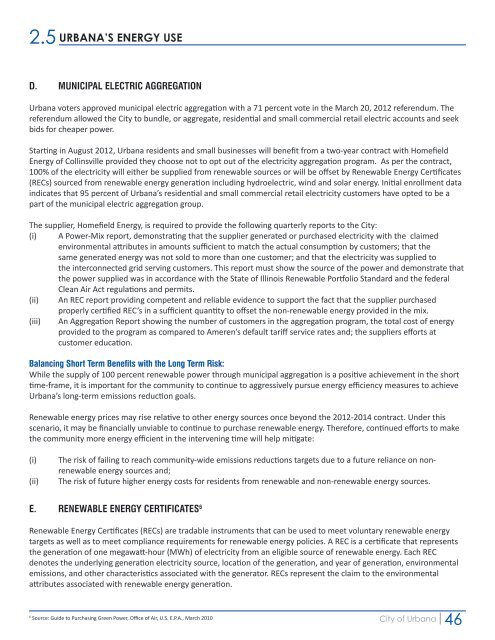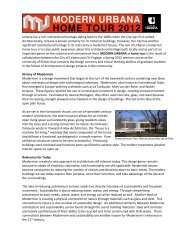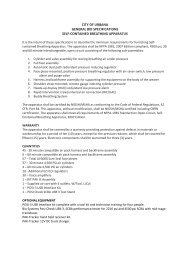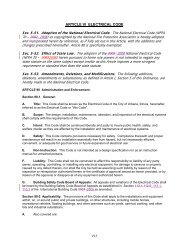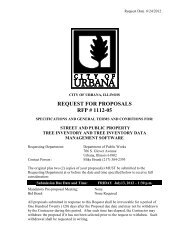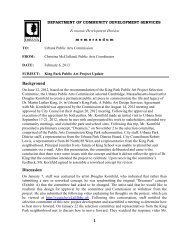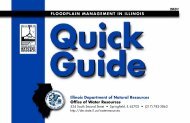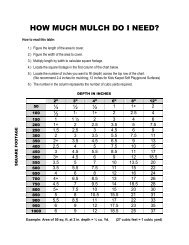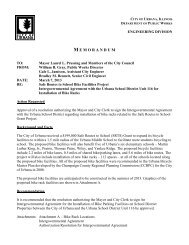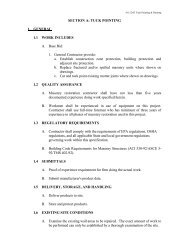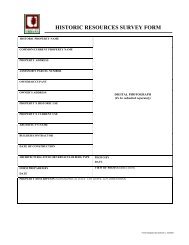CLIMATE ACTION PLAN - City of Urbana
CLIMATE ACTION PLAN - City of Urbana
CLIMATE ACTION PLAN - City of Urbana
- No tags were found...
You also want an ePaper? Increase the reach of your titles
YUMPU automatically turns print PDFs into web optimized ePapers that Google loves.
2.5<br />
URBANA’S ENERGY USE<br />
D. MUNICIPAL ELECTRIC AGGREGATION<br />
<strong>Urbana</strong> voters approved municipal electric aggregation with a 71 percent vote in the March 20, 2012 referendum. The<br />
referendum allowed the <strong>City</strong> to bundle, or aggregate, residential and small commercial retail electric accounts and seek<br />
bids for cheaper power.<br />
Starting in August 2012, <strong>Urbana</strong> residents and small businesses will benefit from a two-year contract with Homefield<br />
Energy <strong>of</strong> Collinsville provided they choose not to opt out <strong>of</strong> the electricity aggregation program. As per the contract,<br />
100% <strong>of</strong> the electricity will either be supplied from renewable sources or will be <strong>of</strong>fset by Renewable Energy Certificates<br />
(RECs) sourced from renewable energy generation including hydroelectric, wind and solar energy. Initial enrollment data<br />
indicates that 95 percent <strong>of</strong> <strong>Urbana</strong>’s residential and small commercial retail electricity customers have opted to be a<br />
part <strong>of</strong> the municipal electric aggregation group.<br />
The supplier, Homefield Energy, is required to provide the following quarterly reports to the <strong>City</strong>:<br />
(i) A Power-Mix report, demonstrating that the supplier generated or purchased electricity with the claimed<br />
environmental attributes in amounts sufficient to match the actual consumption by customers; that the<br />
same generated energy was not sold to more than one customer; and that the electricity was supplied to<br />
the interconnected grid serving customers. This report must show the source <strong>of</strong> the power and demonstrate that<br />
the power supplied was in accordance with the State <strong>of</strong> Illinois Renewable Portfolio Standard and the federal<br />
Clean Air Act regulations and permits.<br />
(ii) An REC report providing competent and reliable evidence to support the fact that the supplier purchased<br />
properly certified REC’s in a sufficient quantity to <strong>of</strong>fset the non-renewable energy provided in the mix.<br />
(iii) An Aggregation Report showing the number <strong>of</strong> customers in the aggregation program, the total cost <strong>of</strong> energy<br />
provided to the program as compared to Ameren’s default tariff service rates and; the suppliers efforts at<br />
customer education.<br />
Balancing Short Term Benefits with the Long Term Risk:<br />
While the supply <strong>of</strong> 100 percent renewable power through municipal aggregation is a positive achievement in the short<br />
time-frame, it is important for the community to continue to aggressively pursue energy efficiency measures to achieve<br />
<strong>Urbana</strong>’s long-term emissions reduction goals.<br />
Renewable energy prices may rise relative to other energy sources once beyond the 2012-2014 contract. Under this<br />
scenario, it may be financially unviable to continue to purchase renewable energy. Therefore, continued efforts to make<br />
the community more energy efficient in the intervening time will help mitigate:<br />
(i)<br />
(ii)<br />
The risk <strong>of</strong> failing to reach community-wide emissions reductions targets due to a future reliance on nonrenewable<br />
energy sources and;<br />
The risk <strong>of</strong> future higher energy costs for residents from renewable and non-renewable energy sources.<br />
E. RENEWABLE ENERGY CERTIFICATES 6<br />
Renewable Energy Certificates (RECs) are tradable instruments that can be used to meet voluntary renewable energy<br />
targets as well as to meet compliance requirements for renewable energy policies. A REC is a certificate that represents<br />
the generation <strong>of</strong> one megawatt-hour (MWh) <strong>of</strong> electricity from an eligible source <strong>of</strong> renewable energy. Each REC<br />
denotes the underlying generation electricity source, location <strong>of</strong> the generation, and year <strong>of</strong> generation, environmental<br />
emissions, and other characteristics associated with the generator. RECs represent the claim to the environmental<br />
attributes associated with renewable energy generation.<br />
6<br />
Source: Guide to Purchasing Green Power, Office <strong>of</strong> Air, U.S. E.P.A., March 2010<br />
<strong>City</strong> <strong>of</strong> <strong>Urbana</strong><br />
46


